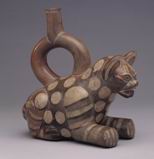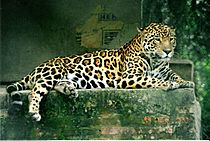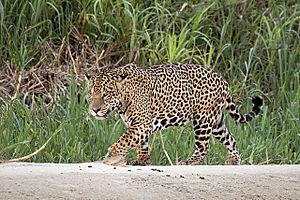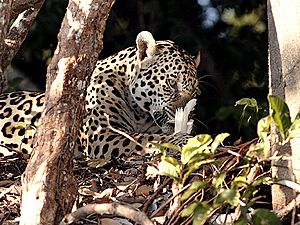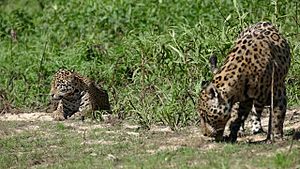Jaguar facts for kids
Quick facts for kids Jaguar |
|
|---|---|
 |
|
| A jaguar at the Milwaukee County Zoological Gardens | |
 |
|
| A "black panther" jaguar | |
| Conservation status | |
| Scientific classification | |
| Kingdom: | |
| Phylum: | |
| Class: | |
| Order: | |
| Family: | |
| Genus: | |
| Binomial name | |
| Panthera onca Linnaeus, 1758
|
|
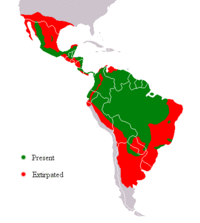 |
|
| Jaguar range | |
The jaguar is a wild cat species and the only member of the genus Panthera native to the Americas. The jaguar's present range extends from Southwestern United States and Mexico and across much of Central America. Though there are single cats now living within the western United States, the species has largely been extirpated from the United States since the early 20th century. It is listed as Near Threatened on the IUCN Red List; and its numbers are declining. Threats include loss and fragmentation of habitat.
The jaguar is the largest cat species in the Americas and the third-largest after the tiger and the lion. This spotted cat closely resembles the leopard, but is usually larger and sturdier. It ranges across a variety of forested and open terrains. The jaguar enjoys swimming and is largely a solitary, opportunistic, stalk-and-ambush predator at the top of the food chain. As a keystone species it plays an important role in stabilizing ecosystems and regulating prey populations.
The cat is frequently killed, particularly in conflicts with ranchers and farmers in South America. Although reduced, its range remains large. Given its historical distribution in pre-Columbian Central and South America, the jaguar was a symbol of power and strength. Among the Andean cultures, a jaguar cult disseminated by the early Chavín culture became accepted over most of what is today Peru by 900 BC.
Contents
Etymology
The word "jaguar" is possibly derived from the Tupi-Guarani word yaguara meaning 'wild beast that overcomes its prey at a bound'. In North America, the word is pronounced disyllabic while in British English, it is pronounced with three syllables. Indigenous peoples in Guyana call it jaguareté. "Onca" is derived from the Portuguese name onça for a spotted cat in Brazil that is larger than a lynx. The word "panther" is derived from classical Latin panthēra, itself from the ancient Greek πάνθηρ (pánthēr).
Appearance
The jaguar, a compact and well-muscled animal, is the largest cat in the New World and the largest carnivorous mammal in Central and South America. Its coat is generally a tawny yellow, but ranges to reddish-brown, for most of the body. The ventral areas are white. The fur is covered with rosettes for camouflage in the light of its forest habitat. The spots and their shapes vary between individual jaguars. Forest jaguars are frequently darker and considerably smaller than those in open area's.
The jaguar stands 63 to 76 cm (25 to 30 in) tall at the shoulders. Compared to the similarly colored leopard, the jaguar is bigger, heavier and relatively stocky in build. A short and stocky limb structure makes the jaguar adept at climbing, crawling, and swimming. The animal has a very powerful bite, even compared to other big cats. Because of its this jaguars can bite through armoured reptiles like caimans, crocodiles, turtles and tortoises.
While the jaguar closely resembles the leopard, it is sturdier and heavier, and the two animals can be distinguished by their rosettes: the rosettes on a jaguar's coat are larger, fewer in number, usually darker, and have thicker lines and small spots in the middle that the leopard lacks. Jaguars also have rounder heads and shorter, stockier limbs compared to leopards.
Evolution
The Panthera lineage is estimated to have genetically diverged from the common ancestor of the Felidae around 9.32 to 4.47 million years ago to 11.75 to 0.97 million years ago, and the geographic origin of the genus is most likely northern Central Asia. Some genetic analyses place the jaguar as a sister species to the lion with which it diverged 3.46 to 1.22 million years ago, but other studies place the lion closer to the leopard.
The lineage of the jaguar appears to have originated in Africa and spread to Eurasia 1.95–1.77 mya. The modern species may have descended from Panthera gombaszoegensis, which is thought to have entered the American continent via Beringia, the land bridge that once spanned the Bering Strait. Fossils of modern jaguars have been found in North America dating to over 850,000 years ago. Results of mitochondrial DNA analysis of 37 jaguars indicate that current populations evolved between 510,000 and 280,000 years ago in northern South America and subsequently recolonized North and Central America after the extinction of jaguars there during the Late Pleistocene.
Two extinct subspecies of jaguar are recognized in the fossil record: the North American P. o. augusta and South American P. o. mesembrina.
| nuclear DNA: | |||||||||||||||||||||||||||||||||||||||
|---|---|---|---|---|---|---|---|---|---|---|---|---|---|---|---|---|---|---|---|---|---|---|---|---|---|---|---|---|---|---|---|---|---|---|---|---|---|---|---|
|
| mitochondrial DNA: | |||||||||||||||||||||||||||||||||||||||
|---|---|---|---|---|---|---|---|---|---|---|---|---|---|---|---|---|---|---|---|---|---|---|---|---|---|---|---|---|---|---|---|---|---|---|---|---|---|---|---|
|
Habitat
At present, the jaguar's range extends from Mexico through Central America to South America, including much of Amazonian Brazil. Jaguars are strong swimmers and climbers, and they often prefer to live by rivers, in swamps, and in dense forest with thick cover for stalking prey.
Jaguars once lived as far north as the southwestern United States. The last wild jaguar in the United States died around 1960. Some of these cats are once again migrating north from Mexico.
In the early 20th century, the jaguar's range extended as far north as the Grand Canyon and possibly Colorado, and as far west as Monterey in Northern California. The jaguar is a protected species in the United States under the Endangered Species Act, which has stopped the shooting of the animal for its pelt. Jaguar skins are also treated as illegal contraband by the US government and otherwise by and large Americans have stopped wearing fur coats made of the pelts of spotted cats as citizens are aware of the international plight of big cats.
Behavior and ecology
The jaguar is mostly active at night and during twilight. However, jaguars living in densely forested regions of the Amazon Rainforest and the Pantanal are largely active by day, whereas jaguars in the Atlantic Forest are primarily active by night. The activity pattern of the jaguar coincides with the activity of its main prey species. Jaguars are good swimmers and play and hunt in the water, possibly more than tigers. They have been recorded moving between islands and the shore. Jaguars are also good at climbing trees but do so less often than cougars.
Ecological role
The adult jaguar is an apex predator, meaning it is at the top of the food chain and is not preyed upon in the wild. The jaguar has also been termed a keystone species, as it is assumed that it controls the population levels of prey such as herbivorous and seed-eating mammals and thus maintains the structural integrity of forest systems. However, field work has shown this may be natural variability, and the population increases may not be sustained. Thus, the keystone predator hypothesis is not accepted by all scientists.
The jaguar is sympatric with the cougar (Puma concolor). In central Mexico, both prey on white-tailed deer (Odocoileus virginianus), which makes up 54% and 66% of jaguar and cougar's prey, respectively. In northern Mexico, the jaguar and the cougar share the same habitat, and their diet overlaps dependent on prey availability. Jaguars seemed to prefer deer and calves. In Mexico and Central America, neither of the two cats are considered to be the dominant predator. In South America, the jaguar is larger than the cougar and tends to take larger prey, usually over 22 kg (49 lb). The cougar's prey usually weighs between 2 and 22 kg (4 and 49 lb), which is thought to be the reason for its smaller size. This situation may be advantageous to the cougar. Its broader prey niche, including its ability to take smaller prey, may give it an advantage over the jaguar in human-altered landscapes.
Diet
Like all cats, the jaguar is an obligate carnivore, feeding only on meat. It is an opportunistic hunter and its diet encompasses at least 87 species. When hunting, they usually try to secretly get very close to the prey, and then the jaguar suddenly jumps at it and throws it down. It then takes the prey to a safe place and eats it. The jaguar is often described as nocturnal, but is more specifically crepuscular (peak activity around dawn and dusk).
The jaguar is a stalk-and-ambush rather than a chase predator. The cat will walk slowly down forest paths, listening for and stalking prey before rushing or ambushing. The jaguar attacks from cover and usually from a target's blind spot with a quick pounce; the species' ambushing abilities are considered nearly peerless in the animal kingdom by both indigenous people and field researchers. The ambush may include leaping into water after prey, as a jaguar is quite capable of carrying a large kill while swimming; its strength is such that carcasses as large as a cow can be hauled up a tree to avoid flood levels.
Jaguars will sometimes wait by the water, hitting it occasionally with their tail. When fish are attracted by this, they swipe out with a paw, spearing the fish in their claws.
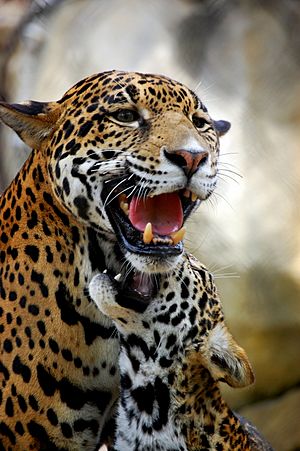
The jaguar is often described as nocturnal, but is more specifically crepuscular (peak activity around dawn and dusk). Both male and female hunt, but males travel farther each day than females, befitting their larger territories. The jaguar may hunt during the day if game is available and is a relatively energetic feline, spending as much as 50–60 percent of its time active. The jaguar's elusive nature and the inaccessibility of much of its preferred habitat make it a difficult animal to sight, let alone study.
Social activity
The jaguar is generally solitary except for females with cubs. In 1977, groups consisting of a male, female and cubs, and two females with two males were sighted several times in a study area in the Paraguay River valley. A radio-collared female moved in a home range of 25–38 km2 (9.7–14.7 sq mi), which partly overlapped with another female. The home range of the male in this study area overlapped with several females.
The jaguar uses scrape marks, urine, and feces to mark its territory. The size of home ranges depends on the level of deforestation and human population density. The home ranges of females vary from 15.3 km2 (5.9 sq mi) in the Pantanal to 53.6 km2 (20.7 sq mi) in the Amazon to 233.5 km2 (90.2 sq mi) in the Atlantic Forest. Male jaguar home ranges vary from 25 km2 (9.7 sq mi) in the Pantanal to 180.3 km2 (69.6 sq mi) in the Amazon to 591.4 km2 (228.3 sq mi) in the Atlantic Forest and 807.4 km2 (311.7 sq mi) in the Cerrado. Studies employing GPS telemetry in 2003 and 2004 found densities of only six to seven jaguars per 100 km2 in the Pantanal region, compared with 10 to 11 using traditional methods; this suggests the widely used sampling methods may inflate the actual numbers of individuals in a sampling area. Fights between males occur but are rare, and avoidance behavior has been observed in the wild. In one wetland population with broken down territorial boundaries and a high population density, adults of the same sex have been observed fishing, traveling and playing together.
The jaguar roars or grunts for long-distance communication; intensive bouts of counter-calling between individuals have been observed in the wild. This vocalization is described as "hoarse" and contains five or six guttural notes. Chuffing is produced by individuals when greeting, during courting, or by a mother comforting her cubs. This sound is described as short, low intensity, non-threatening snorts, possibly intended to signal tranquility and passivity. Cubs have been recorded bleating, gurgling and mewing.
Reproduction
Females provide all parenting. The gestation period lasts 93–105 days; females give birth to up to four cubs, and most commonly to two. The young are born blind, gaining sight after two weeks. Cubs are weaned at three months, but remain in the birth den for six months before leaving to accompany their mother on hunts. They will continue in their mother's company for one to two years before leaving to establish a territory for themselves. Young males are at first nomadic, jostling with their older counterparts until they succeed in claiming a territory. Typical lifespan in the wild is estimated at around 12–15 years; in captivity, the jaguar lives up to 23 years, placing it among the longest-lived cats.
Images for kids
See also
 In Spanish: Panthera onca para niños
In Spanish: Panthera onca para niños



